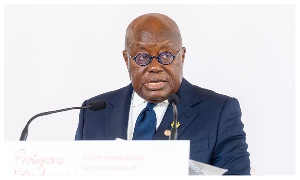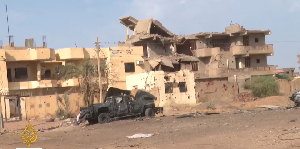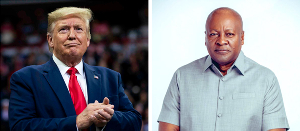Time and again, I have written and maintained that the development of football in any country greatly dwells on the willingness of the government to help.
Organized football, which has become a major tool for national development, is not played just anywhere, and for that matter, the development of the game greatly rests on the availability of infrastructure to harness the talents that abound in the country.
Football development rests on the structures that are laid down by the country and for that matter, Ghana must wake up to the call if indeed we aim at developing the game.
It is because of this that I was greatly overjoyed when President John Mahama, in delivering the State of the Nation Address in 2013 promised to build one ultra-modern sports complex in every district in Ghana. Sadly, this was never a promised fulfilled.
The current government, the NPP, led by President Akufo-Addo, have done considerably well in the field of sports infrastructure development by erecting the ten sports development centers in the traditional ten regions as well as spreading the construction of AstroTurf pitches across the country.
Of course there are some important questions that can be asked about the quality of the facilities, how it will be put to use profitably and many more. However, the bottom line is, sports infrastructure has seen a massive facelift under this government than the previous government. And this, is from an honest point of view.
The English Premier League, in its current form, began in 1992 and, if you watch clips before that time, you will see that they had issues with the pitch (quite muddy), the jerseys (too short, too long, too big) and all that, but the moment it was re-organized as the EPL, it became a standard for the rest of the world.
What baffles me much is that many compare the Ghana Premier League to the English Premier League in most cases when structural arguments pop up.
Strangely enough, no one has talked about what they did to get to where they are today.
They got to this point gradually, it was not spontaneous. The English government intervened to creating the platform for what they have today. And that has been the role of all governments in developed countries – facilitating the growth of the industry through infrastructure development.
In 1991, the government of England made available a grant of £200m to develop the league. The money was not handed over to the clubs, no.
It was used to upgrade the stadia to be right for commercialization of football, get the right television equipment for coverage, branding and the rest.
Now, they have a finely developed league, everything looks ship-shape and the fans feel comfortable in the stadia, a far-cry from what it used to be before the UK government’s intervention; when the stadia were places of violence, structural collapse and all manner of frightening things.
Today, that investment of £200m earns the government over £3bn in taxes and other businesses involved with football, which has become a main-stay of their economy.
That is the kind of platform we need to have as a pure, true, professional league; having the right television equipment, playing on the right grounds, branding and all that.
The case of the EPL and the role of the English government in catapulting their football industry isn’t different from Ghana. Check the quality of pitches used for Ghana Premier League games, not to even talk of Division One League games.
Similarly, as in Ghana, the government can take up the establishment of football stadia for football clubs in the country to provide an enabling environment for the development of the game.
That will contribute to making our game look good on television to lure sponsors, it will raise the standard of the league, clubs can make more money from the gates, sponsors etc and can then pay players well to retain quality in the league; money is then retained in the economy, the government gets revenue from the gates, employment is created, unemployment reduces, …and the cycle continues in a vicious manner.
Football is a medicine for poverty, if and only if the government pays attention to the industry.
Even the television money can suffice for the day-to-day running of the league if the appropriate environment is provided.
Over here, we are all trying to do it our own, by using money from private individuals.
There is, virtually, little or no support from the government at the center, yet that is the body that frustrates the free flow and the snail-pace development of the game.
A simple internet surfing research has revealed that many governments in several countries around the world take center stage in the development of infrastructure for the game but not in Ghana.
In 2012, the government of Malta handed over €9million to clubs to enable them to build and improve football facilities to include synthetic pitches in 19 more football clubs after 33 had benefitted from such project since 2008.
In 2013, the Colombian government set aside $218million exclusively for investment in sports infrastructure development and training. The local and regional governments invested $150million in infrastructure and set aside a $22million to prepare local competitors.
Investment in football facilities in Colombia has predominantly been made with state or public capital, as most teams do not have sufficient financial capacity to build their own facilities.
The Scottish Government was proud to sponsor the Scottish Communities League Cup (now Scottish League Cup) to the tune of £1.7million in the 2012/13 season.
The Scottish Government invested in the Scottish Communities League Cup to support the delivery of the tournament and supporting football clubs in villages, towns and cities across Scotland.
About 4 years ago, the Ireland Government unburdened themselves with €7.4million for a range of grassroots and youth development projects across the sporting spectrum.
The basic thrust of the funding push was to increase sports participation throughout Ireland. This includes coach development, club support, underage programs etc.
The Ethiopian Central Government in conjunction with the federal governments commenced the process of erecting ten new stadiums in the country with at least nine of them close to completion in 2016.
The Adey Abeba Stadium (1) and a blue print for another stadium (2) coming up in Addis Ababa, Gambella Stadium (3), 30,000 seater is on course in the Gambella City, west of Addis Ababa. In the Southern part of the country, the Bahir Dar Stadium (4) is almost complete whilst Makelle Stadium (5) also being finished up in Makelle City. Still in the southern region, there is Nekemte Stadium (6) also ongoing in Nekemte town. The Adama Stadium (7) in Adama City is close to completion with a reported 80,000 capacity. In the East of Addis Ababa, close to Somalia border, the Dire Dawa Stadium (8) comes up. Hawassa Stadium (9) which hosted some CECAFA 2015 matches is also a new stadium. Sheikh Hussein Ali Alamoudi Stadium (10) in Woldia was also funded by a Saudi Arabia-based Ethiopian billionaire Ali Alamoudi.
This is what Ethiopia has done and is still doing to develop their game. What are we doing in Ghana?
I spoke to a colleague sports journalist in Nigeria about football infrastructure in the country. He told me 95% of the football stadia and pitches in the country were constructed by government with only a few by the clubs themselves.
“In a little more than a decade, Germany has invested nearly $1 billion in its youth programs, with academies run by professional teams and training centers overseen by the national soccer association, the DfB.
“The programs testify to the long-term strategic thinking and to the considerable resources that have driven Germany’s rise to renewed prominence in — and at the expense of — a struggling continent,” according to nytimes.com
We see countries investing huge sums of monies into the development of infrastructure which in the long run becomes the backbone of football in the country, yet we take delight in listening to our government making excessive unfulfilled promises.
It is sad that the Ghanaian government accepts that building schools, hospitals and constructing roads are their responsibilities yet when it comes to building facilities for the development of football, they frown.
The argument that football clubs are privately owned and that government has no business in investing in the development of facilities is flawed right from the onset because developing sports infrastructure is a statutory requirement.
Is the Ghana Education Service responsible for the building of schools in the country? Is the Ghana Health Service responsible for the building of hospitals in the country? If no, why is the government neglecting football? Or has the government stopped providing private schools with text books and other educational equipment because they are private schools?
The effort of the current government is a confirmation that the development of the game dwells on the availability of infrastructure and as such, a lot can be done and must be done.
Football is a tool for poverty alleviation. Football is a life changer.
If the UK government can shrewdly pump in £200m in 1991 to take English football where it is today; if the Malta government can put in €9m in football infrastructure development in 2012; if the Colombian government can invest $218m in 2013 in football infrastructure development; if the Scottish government can provide $1.7m in 2012 to sponsor the Scottish League Cup; if the Irish government can provide €7.4million for a range of grassroots and youth development projects across the sporting spectrum in 2015; if the German government can flush in $1b in 2001 to turn the fortunes of German football, then what is the Ghana government doing?
Sports Features of Friday, 9 April 2021
Source: footballmadeinghana.com

















